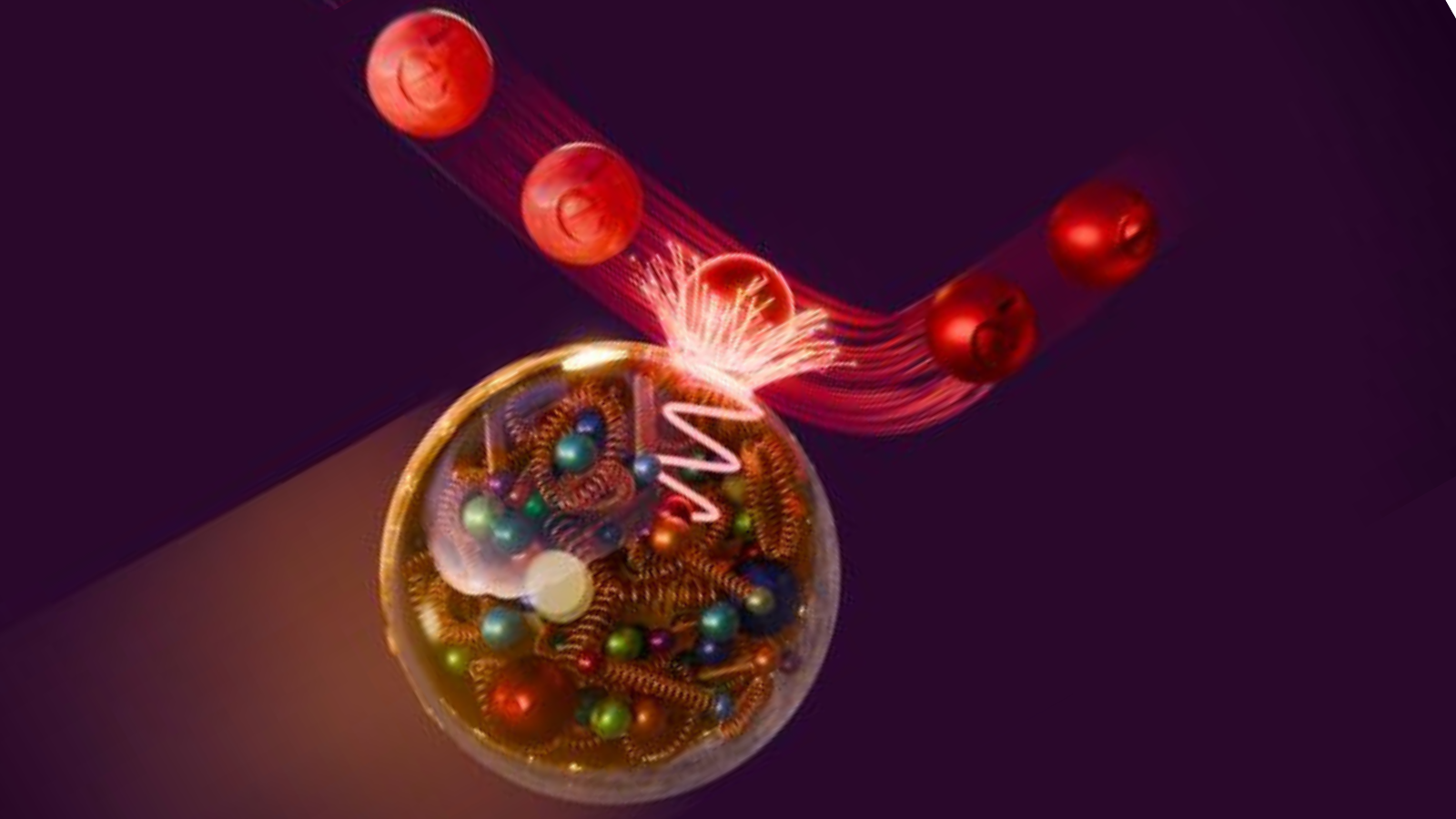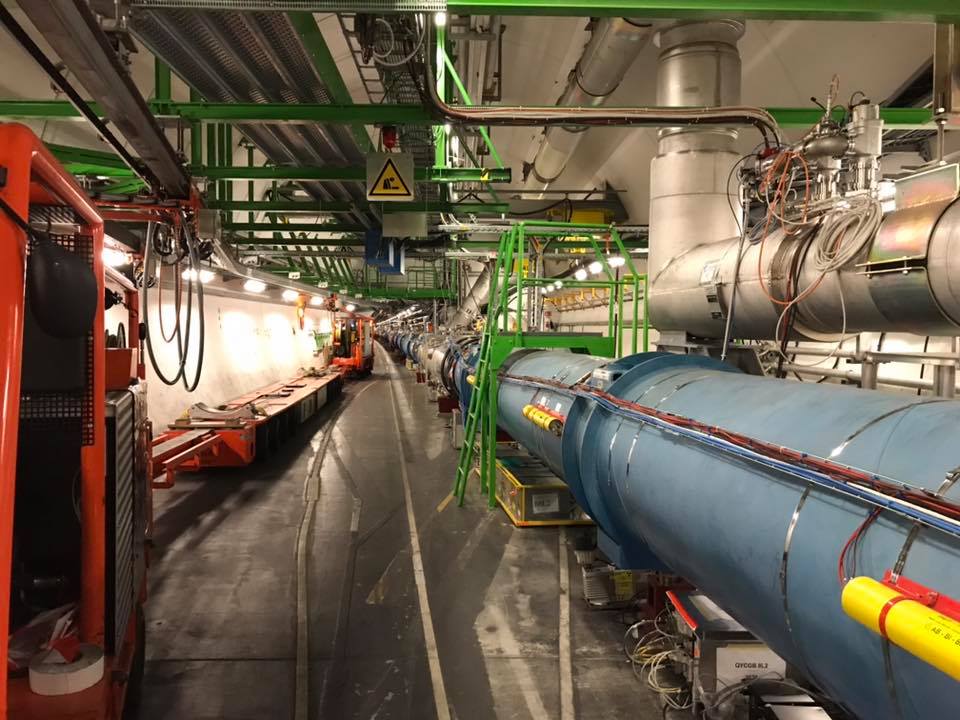
Scientists have used high-energy particle collisions to peer inside protons, the particles that sit inside the nuclei of all atoms. This has revealed for the first time that quarks and gluons, the building blocks of protons, experience the phenomenon of quantum entanglement.
Entanglement is the aspect of quantum physics that says two affected particles can instantaneously influence each other's "state" no matter how widely separated they are — even if they are on opposite sides of the universe. Albert Einstein founded his theories of relativity on the notion that nothing can travel faster than the speed of light, however, something that should preclude the instantaneous nature of entanglement.
As a result, Einstein was so troubled by entanglement he famously described it as "spukhafte Fernwirkung" or "spooky action at a distance." Yet, despite Einstein's skepticism about entanglement, this "spooky" phenomenon has been verified over and over again. Many of those verifications have concerned testing increasing distances over which entanglement can be demonstrated. This new test took the opposite approach, investigating entanglement over a distance of just one quadrillionth of a meter, finding it actually occurs within individual protons.
The team found that the sharing of information that defines entanglement occurs across whole groups of fundamental particles called quarks and gluons within a proton.
"Before we did this work, no one had looked at entanglement inside of a proton in experimental high-energy collision data,” team member and Brookhaven Lab physicist Zhoudunming Tu said in a statement. "For decades, we’ve had a traditional view of the proton as a collection of quarks and gluons, and we’ve been focused on understanding so-called single-particle properties, including how quarks and gluons are distributed inside the proton.
"Now, with evidence that quarks and gluons are entangled, this picture has changed. We have a much more complicated, dynamic system."
The team's research, the culmination of six years of work, refines scientists' understanding of how entanglement influences the structure of protons.
Entanglement gets messy
To probe the inner structure of protons, scientists looked at high-energy particle collisions that have occurred in facilities like the Large Hadron Collider (LHC). When particles collide at extremely high speeds, other particles stream away from the collision like wreckage flung away from a crash between two vehicles.
This team used a technique developed in 2017 that applies quantum information science to electron-proton collisions to determine how entanglement influences the paths of particles streaming away. If quarks and gluons are entangled with protons, this technique says that should be revealed by the disorder, or "entropy," seen in the sprays of daughter particles.
"Think of a kid’s messy bedroom, with laundry and other things all over the place,” Tu said. "In that disorganized room, the entropy is very high."
The contrast to this is a low-entropy situation which is akin to a neatly tidied and sorted bedroom in which everything is organized in its proper place. A messy room indicates entanglement, if you will.
"For a maximally entangled state of quarks and gluons, there is a simple relation that allows us to predict the entropy of particles produced in a high-energy collision," Brookhaven Lab theorist Dmitri Kharzeev said in the statement. "We tested this relation using experimental data."

To investigate how "messy" particles get after a collision, the team first turned to data generated by proton-proton collisions conducted at the LHC. Then, in search of "cleaner" data, the researchers looked to electron-proton collisions carried out at the Hadron-Electron Ring Accelerator (HERA) particle collider from 1992 to 2007.
This data was delivered by the H1 team and its spokesperson as well as Deutsches Elektronen-Synchrotron (DESY) researcher Stefan Schmitt after a three-year search through HERA results.
Comparing HERA data with the entropy calculations, the team's results matched their predictions perfectly, providing strong evidence that quarks and gluons inside protons are maximally entangled.
"Entanglement doesn't only happen between two particles but among all the particles," Kharzeev said. "Maximal entanglement inside the proton emerges as a consequence of strong interactions that produce a large number of quark-antiquark pairs and gluons."
The revelation of maximal entanglement of quarks and gluons within protons could help reveal what keeps these fundamental particles bound together with the building blocks of atomic nuclei.
Uncovering details of the entanglement between quarks and gluons could help scientists research deeper problems in nuclear physics, such as how being part of larger atomic nuclei impacts the structure of protons. For instance, does putting a proton in a very busy nuclear environment surrounded by many interacting protons and neutrons destroy the entanglement, a process called "quantum decoherence," with the individual protons?
"To answer this question, we need to collide electrons not just with individual protons but with nuclei,” Tu said. “It will be very helpful to use the same tools to see the entanglement in a proton embedded in a nucleus — to learn how it is impacted by the nuclear environment.”
This will be one of the key investigations undertaken by Brookhaven Lab's forthcoming Electron-Ion Collider (EIC). As such, these results could be an important part of the roadmap for the EIC, which is set to begin operations in 2030.
"Looking at entanglement in the nuclear environment will definitely tell us more about this quantum behavior — how it stays coherent or becomes decoherent — and learn more about how it connects to the traditional nuclear and particle physics phenomena that we are trying to solve," Tu concluded.
The team's research was published in the journal Reports on Progress in Physics.







